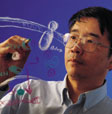 Targeting
the triggers "We believe that between 30 and 50 tyrosine kinases are expressed in a particular cell type," said Kung, "and both cancer and noncancer cells probably share most of the same ones. But if we can identify the few that are different, we will know that they control the different behavior of cancer cells. They would also provide wonderful markers for detection and for devising strategies to interrupt their activity." It couldn't be a better time to be doing this work, the researcher said. "Genetic and molecular approaches have been developing that allow individual laboratories like ours to achieve significant breakthroughs," said Kung, who holds numerous grants from the National Institutes of Health, including two distinguished merit awards. "It means our discoveries in basic science laboratories may be more easily translated to the clinical side of medicine." Fueling Kung's optimism is a three-year-old technological development - a tyrosine kinase display system - made by Daniel Robinson, one of four researchers at Kung's Case Western lab who will join him at the cancer center later this year. This display system allows researchers to describe all the different tyrosine kinases a cell expresses in a single analysis showing which of the kinases are expressed and how much enzyme they are producing. "Remembering our goal - to identify markers in cancer cells that explain their different behavior - this allows us to see all the tyrosine kinases genes that are aberrantly expressed in a cancer cell," said Kung. "Before, this was extremely difficult because it required cloning and sequencing of individual genes, a time-consuming process that takes a while to complete." The tyrosine kinase display is not as sophisticated as more advanced microarray, or chip technology, approaches that allows researchers equipped with laser scanners and chip-production facilities to look at all the genes expressed in a single cell at one time. But it's cheaper and easier to use and also has equal power and perhaps greater sensitivity in detecting tyrosine kinase activity. "Our approach should complement the micro- array analysis and can be done by any molecular genetics lab," said Kung. "It takes no special training, and already 20 other labs are adapting it for their own use." While the new process is at present applied only to tyrosine kinases, Kung believes the procedure can be extended to other gene families. But in his view, tyrosine kinases make the best possible target for cancer researchers. "We will need to know about the activity of other genes because cancer is undoubtedly caused by the actions of a combination of oncogenes, but we're fairly confident that tyrosine kinases are key players," he said. Kung and his research associates have already put their kinase display process to good work. In a paper published earlier this year in the prestigious journal Nature, Kung reported that a particular tyrosine kinase known as erbB2, which is always expressed at fairly high levels in prostate cancer cells, actually triggers the aberrant cell growth by growth factor and cytokine that leads to cancer. "ErbB2 is a receptor molecule located on the surface of prostate cells," said Kung. "Usually when growth factors are nearby, this particular tyrosine kinase can be activated and then transmit a signal to the nucleus of the cell that instructs it to grow. We now know that in prostate cancer cells, erbB2 can be activated not only by growth factors but also by cytokines such as interleukin 6." These findings, according to Kung, elucidate how prostate cancer cells grow and differentiate and also provide fundamental knowledge about how different types of receptor molecules interact with one another. Kung's team is also investigating the relationship between retroviruses that cause cancer - such as HTLV, which causes some cases of leukemia - and the ubiquitous family of herpesviruses, which are associated with such cancers as Burkett's lymphoma and nasopharyngeal carcinoma. "Though they reproduce in different ways, herpesviruses and retroviruses are both major human pathogens," said Kung. "Because we know that both can cause cancer, our lab became interested in studying what happens when an organism is infected with both." Using a chicken model infected with both types of viruses, Kung and his associates have found that the presence of both viruses in the same cell enhances the potency of the resulting cancer. Much work remains to illuminate the precise mechanism, but Kung has already made a startling discovery. "We found that these viruses - one of which is a DNA virus, the other an RNA virus - can recombine within the cell," he said. "That means that they can reshuffle their genetic material and potentially create a new chimeric virus." Fortunately, according to Kung, the coincidence of both a retrovirus and a herpesvirus infecting the same cell probably occurs only rarely in humans. "But this work shows that in theory this reshuffling of genetic material by RNA and DNA viruses can be a very efficient process, one that we will need to keep an eye on," said Kung.
Home |
Table of Contents |
To our Readers |
Building on Basics UC Davis Health System | © 2000, 2001, 2002 UC Regents. All rights reserved. |
For more than 20 years, cancer researcher Hsing-Jien kung has been studying the process by which cells become cancerous and the differences between them and those that remain healthy. |

